
The Corona pandemic not only brought the competition circuit to a forced standstill, but at the same time also the numerous seminars intended to take place during the spring time. In Germany the national equestrian federation is well known for regularly organizing such high level training seminars in all parts of the country and what better way to restart them than featuring one of Germany’s most successful dressage riders of the past decade, Helen Langehanenberg.
At the German Olympic Equestrian Center in Warendorf she held a ridden seminar generically titled "The training of the dressage horse" in front of over 130 interested spectators. She impressively showed how to cleverly and classically train dressage horses of different levels.
Corona Seminars
Without a doubt the first post Corona lockdown seminar organized by the Personal Members section of the German FN was a huge success which started with very disciplined spectators who actually arrived on site one by one and were not only welcomed by the friendly staff of the FN, but also by hand sanitizer spenders at the entrance of the Olympic Center’s big seminar hall.
Everybody was seated according to valid Corona rules which took some time, but it was efficiently done by the staff.
The atmosphere on this sunny, but luckily, for once, not too hot summer evening was relaxed and interested. Two officials re-iterated the obligatory Corona rules at such events: the one-way-system on the tribune along the long side and wearing masks as soon as leaving the seats. A bit surprisingly not too many questions were posed by the audience in the course of the evening although they were regularly addressed and asked. Usually people make good use of this at hese seminars and sometimes it becomes even difficult to channel all questions, but perhaps Helen’s logical and convincing approach to the four horses, which had been well chosen for this event, left little left to ask about.
The four horses and riders of the seminar were two five and two seven years old horses, representing novice (A/L) to advanced level (M/S).
Many Ways Lead to Rome
Helen welcomed the audience with the following words: „many ways lead to Rome. On this evening - which will hopefully be a relaxed one - I introduce you to my approach.“
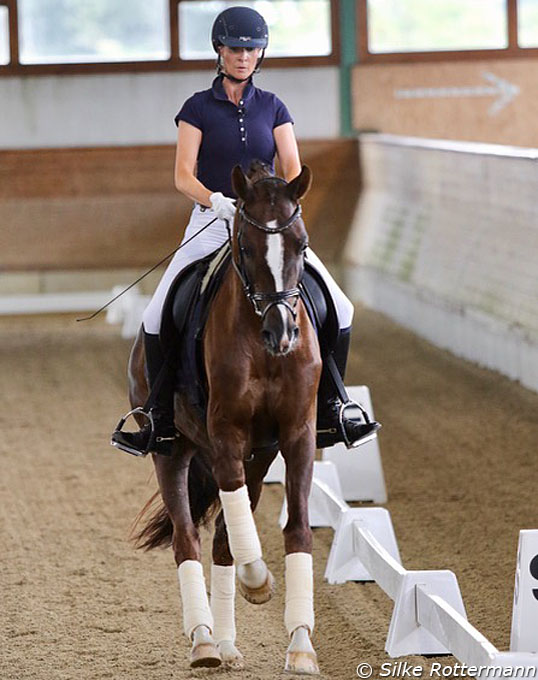
Ridden by Ruth Elkmann from Beelen near Warendorf the sympathetic youngster was introduced by his rider as „an obedient horse which sees all“. Broken in at 4 years of age, Quite Perfect Franz is already placed at dressage horse A-classes this year.
The charming horse was quite understandably a bit impressed by the surroundings and the over 200 pairs of eyes staring at him in the big indoor arena. Helen immediately mentioned it to the audience and took a bit pressure off the rider to who she advised to go on the second track to create more distance to the spectators. Therefore, she phrased that the first goal to work on is an authentic forward-downward-position and ride transitions to relax the horse, who initially rushed a bit in his tempo.
Helen stressed that while rushing isn’t desired, „it is important to ride a free natural tempo with young horses, a tempo which suits the horse.“ The connection to the horse’s mouth should always be taken from the activity of the hindquarters and over the back. A connection like this also prevents the horse to fall onto the forehand when it is allowed to chew the reins out of the hands. Helen did not become tired to stress that the rider has to maintain the horse’s preparedness to stretch throughout.
To relax the horse she recommended transitions at the beginning, but added that it depends on the horse if walk-trot-walk or trot-canter-trot transitions are favoured. In principle, the latter are more suitable for an excited or tense horse to start relaxing. While it is an understandable reaction, riders often tend to "hold" such horses in front, but it is an old saying that pressure always creates counter pressure and the aim has to be that the horse stretches the neck and seeks the contact in an honest way.
Collection when the Contact is Honest
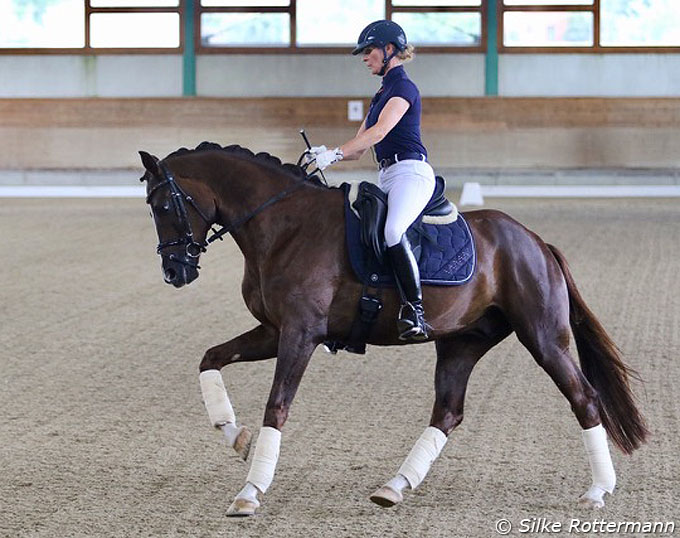
Helen encouraged the rider again and again to „lengthen the reins and allow the horse to chew the reins out of the hand until the buckle of the reins“, a saying which the late Paul Stecken became famous for. Stecken had not only been mentor to Ingrid Klimke, but Klimke was Helen's early coach and influence as she did her apprenticeship at Ingrid's yard. There she got to know Damon Hill. Progressively Ruth Elkmann could put that more and more into practice, always positively reinforced by Helen saying "It doesn’t matter what happens, lengthen the reins."
The more the lesson progressed, the more the chic liver chestnut visibly relaxed and finally not only moved with a longer neck, but began to swing and make full use of his athletic body.
Be Brave as a Rider
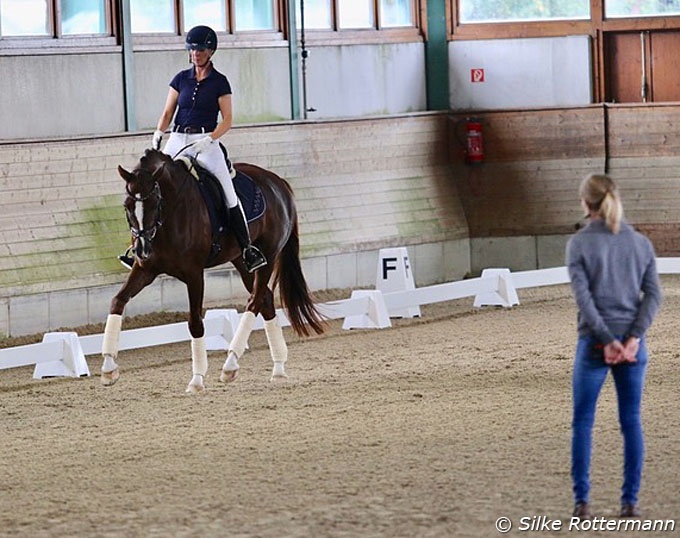
The spectators were impressively demonstrated that a lesson means by far not always working on movements, but overall on the basics. In that case it means achieving and maintaining the horse’s ability to reach out to the bit with a stretched neck. No movement can ever become good, if the first condition is not correctly done and secured.
The horse’s mental relaxation is a precondition for him to stay physically relaxed and able to listen and learn new things.
On Good Mouths and Improving Rhythm
The second horse of the evening was the identically aged 5-year-old mare Charming Sezana, a long legged Oldenburger mare by Sezuan out of a Fürst Heinrich dam, presented by Claire-Louise Averkorn, a former German European Junior and Young Rider Team champion and now a successful national U 25 Grand Prix rider. Averkorn trains at the Olympic Center in Warendorf.
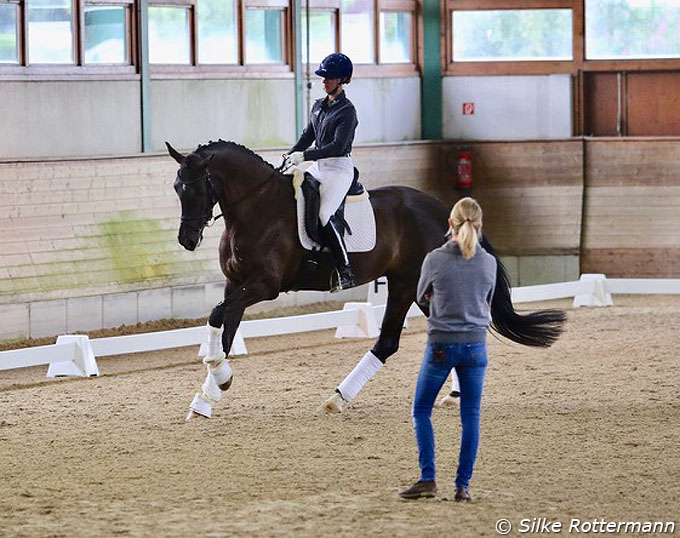
While the mare showed her ability to stretch in these two basic gaits, Helen recommended the rider to take it into the transition to the walk: „Take the bit forwards and try to lengthen the transition in a way as if the horse wants to carry the spring into the walk. The horse has to march relaxed.“
To improve the rhythm of the walk Helen suggested that the rider tries to feel every single step of the walk, which was of an exceptional quality in the young Sezuan-offspring. Her inner peace reflected beautifully in her way of going and in the expression of her face.
While riding transitions the horse has to be in front of the rider and await his aids. "Diligent and thinking horses are great, but the horse has to allow the rider to prepare a movement and not to anticipate it," Helen explained. While it is surely useful to exercise from time to time movements, which dressage programmes require, it should not become the daily norm because it bores the horse and fosters exactly this anticipation which is not desired. Instead the rider has to be clever and needs to have different tools at his disposal to exercise movements in a way that they keep the horse interested and pay attention to the rider.
After collection Open the horse’s Frame
Like with the pair before, Charming Sezana and Claire-Louise Averkorn Helen did not become tired to mention that in all we do, it is most important that the gait’s quality has to be maintained (or improved) when riding movements.
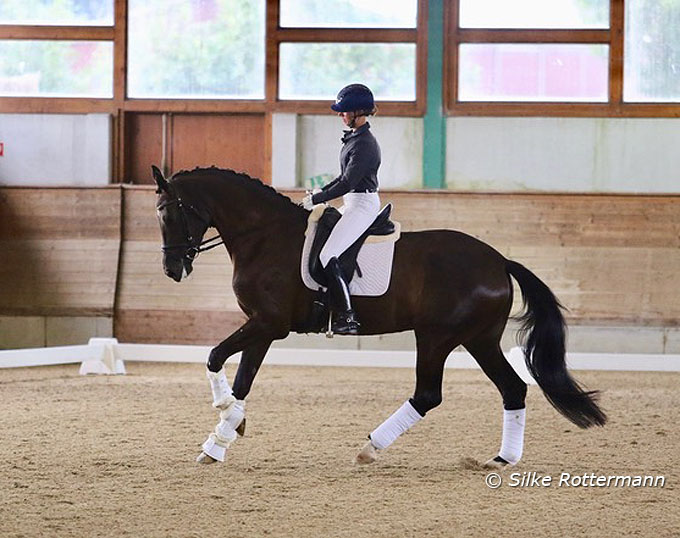
This regular change between more collection and forward or walk breaks is not an exclusive hallmark of Helen’s work, but it was delighting to watch the positive effect on the horses. „After collection we need to open the horse’s frame and let them allow to be longer again“.
To improve the working trot, of the elegant mare, Averkorn was asked to ride loops through the arena on which small tempi changes should be practised. "Allow your horse to become big and trot uphill," Helen encouraged the young German. What is easier said than done, was successfully put into practice by Claire-Louise who took care the mare remained relaxed, but attentive and executing these ever so slight tempi changes like a smooth oiled machine. Indeed, Sezana became more expressive and developed more swing in her strides, being focused on her rider all the time. "The horse has to have positive tension, but the rider has to be careful that it is not changing into a negative one," Helen warned.
Teach with Building Blocks: Basic Routine, Experience, Improvement.
After a small break in which the spectators mainly remained at their seats and discussed what they just had seen, the 25-year-old Sabrina Geßmann from Münster entered the arena with Helen’s home-bred 7-year-old mare Drama Queen. In a way this pair is fairly „home-made“ because Geßmann is Helen’s in-house rider for over 5 years now, while also working at her parent’s stable in Münster. The blonde, who also successfully jumped to medium level, presented this chestnut mare by Deveraux - Louis Le Bon at the 2018 World championships for 5-year-olds in Ermelo and just recently Drama Queen earned her first placing at S-level.
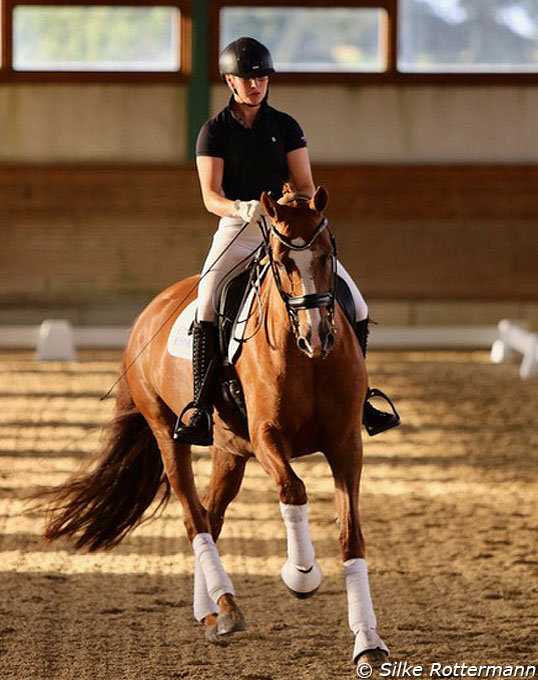
"With a young horse the half-pass needs to be worked on like a puzzle. Once you put your focus on the forwards-sideways driving aid and ride it without flexion and bend. Once you ride with a flexion straight forward and once you ride with longitudinal flexion across the diagonal.“ When putting it all together later on the horse will find it easier to execute and bring it all together. Langehanenberg’s training system is based on the logical succession of "basic routine, experience, improvement."
To maintain the fluidity of the movement and prevent the fatal pressing of the horse sideways, it is also useful not to ask a whole diagonal, but ride the half-pass like a staircase, Helen explained to the attentive audience: "A half-pass is only as good as the gait it is ridden in. To maintain, for example, active canter strides and the forward propulsion do not ride a whole diagonal, but break it in parts and ride a few straight strides in between.“ She continued that „if you attempt half-passes with a steeper angle later on in the training of your horse, it is important that the horse realizes he can do it. So with a younger horse I guess my line and ride along it, but at the same time I do not expect it to be a perfect half-pass in all aspects.“
Helen stressed that a good half-pass is not only characterized by the purity of the gait, the fluidity of the movement, but also by a clear and correct introduction and end.
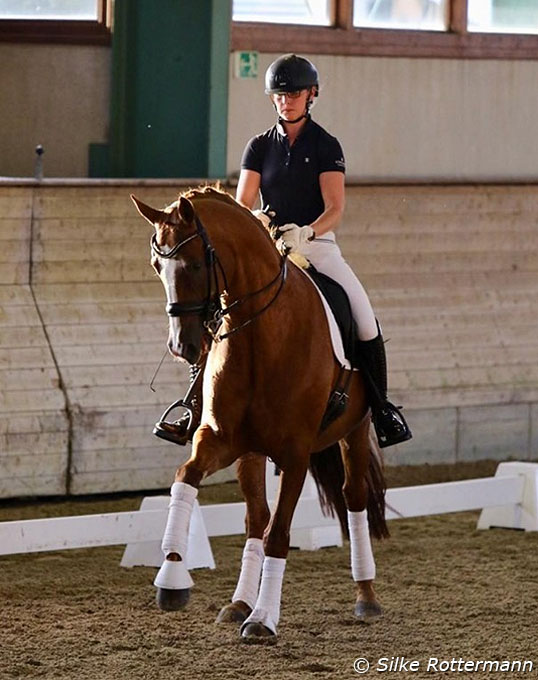
Sabrina Geßmann and the 7-year-old mare put everything their trainer said exemplarily into practice. Even though young and comparatively new at that level, the mare whose name Drama Queen does not match her attitude well that evening because she was relaxed and attentive, played with the lateral movements in canter and trot. Frame, contact and balance were established to a degree that show-cased her breeder’s and her rider’s realistic training along the German guidelines.
Again, Helen drew the attention on having the horse in front of the rider at all times and talked about the importance of not always practicing the lateral movements of a Prix St. Georges or a Grand Prix exactly like required there to not get horses used too much to the sequence, so they remain on the aids, listens to the rider and do not anticipate them.
„Whatever we practice, the constant change of positive tension and relaxation is paramount, so allow the horse regular breaks for body and mind. Do not forget that the horse must be as happy as you during the training session.“
Corners and Short Sides
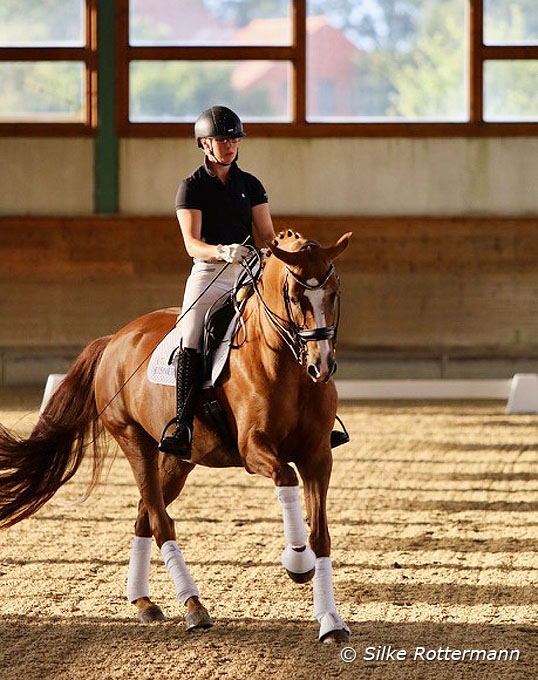
It becomes easily apparent that correct riding is also clever riding. „Principally crossing a corner means riding a quarter volte, but it also depends on the training level of a horse how deep I ride into a corner. If I pass corners correctly as a quarter volte and ride deep into them, the short side automatically becomes longer and this in turn gives me more time to prepare the next movement.“
Passing corners correctly was no problem for the willing Sir Stanley, who was asked to ride the popular succession of passing a corner in trot and then go into shoulder-in along the long side of the arena. Helen asked Claire-Louise to check the horse’s longitudinal flexion and degree of self-carriage by giving the inside rein („überstreichen“) for a moment and ask for small tempi changes within the lateral movement. "The horse should learn to carry himself," Helen remarked who also asked the rider to check with how small the aids can be and still ride the movement.
Dressage is Clever Gymnastics
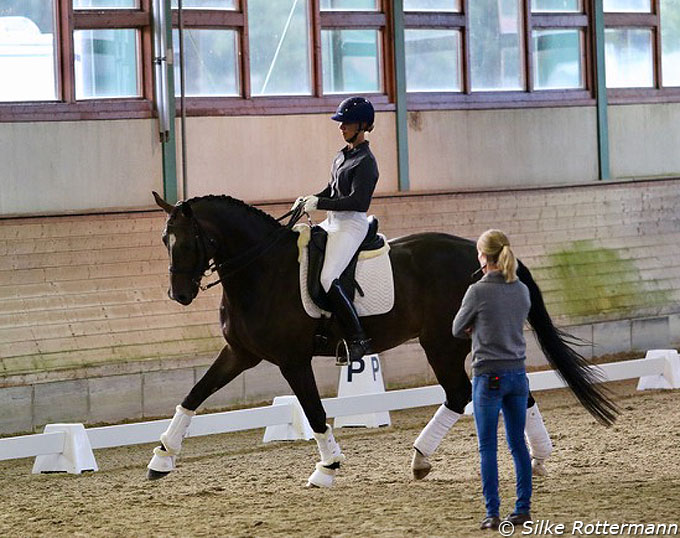
During this short-whiled evening Helen never tired to stress a few things which apply to any training level:
=> To put the focus on the horse’s relaxation.
=> Not to expect movements to be perfect during the learning process.
=> To look for and keep the correct contact.
=> To focus on keeping the gaits pure in order to achieve good movements.
=> To vary the movements so that the horse does not anticipate, but stays in front of the rider.
These three hours once again made clear that dressage is clever gymnastics for the horse and that the classical approach keeps all necessary tools ready for a rider to train in a way that respects the horse’s physical and mental integrity while aiming to compete at the highest levels in the discipline.
Those who love to waive their finger and accuse the "German system" as a bad system only because some do not follow its guidelines, should better make the effort to attend a seminar like this than spending hours of harassing others on social media.
Text and Photos by Silke Rottermann
Related Links